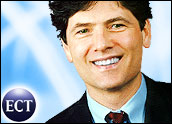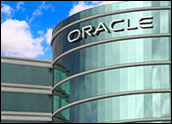
SAP’s abrupt announcement that golden boy Shai Agassi was leaving the company last week hit like a proverbial ton of bricks. The initial announcement said all the right things about Agassi wanting to pursue other options, and board chairman Hasso Plattner made the usual remarks about still being friends and the mutuality of the decision — but you have to suspect that there’s a back story.
The 37-year-old Agassi has been sort of a wunderkind, or rising star, at SAP since it bought his company TopTier Software in 2001. Agassi has been the motivating force behind NetWeaver and SAP’s on-demand strategy. As recently as January, SAP announced that it was investing in a new business model driven by on-demand that would deliver products and services in a software-as-a-service model to the mid-market.
Many people, myself included, figured this was the beginning of SAP’s long awaited response to the on-demand initiatives of the last decade in which SAP seemed to stake a head start companies like Siebel, NetSuite, RightNow and, of course, Salesforce.com.
I thought the idea was brilliant — a mature company in a market that is being disrupted sees the writing on the wall and takes decisive action to change its game.
Behind the new business model announcement I could see a strategy of proving the model and then moving it upstream to SAP’s largest customers. SAP, I thought, would become one of a few information utilities on the planet. Now, who knows? It takes vision and leadership to pull something like that off. SAP doesn’t lack leadership, but I wonder about its vision.
A Tale of Two Companies
A few years ago I recommended that Siebel (then still independent) buy itself back from its shareholders. At the time, the company was stagnating; it was the software company that had reached the US$1 billion plateau faster than any in history, and, although it recorded revenues as high as $2 billion at one point, it was moving sideways.
My recommendation was based on the fact that Siebel had about $2 billion in the bank and a lot of institutional shareholders who were getting impatient with the company’s drift. The founders were still involved and were pretty wealthy to begin with, and attracting the necessary capital for a management buyout was certainly possible.
Why not go private, I thought? The company’s problems were in part based on price and the total cost of ownership of its traditional product offering at a time when delivery models were in flux.
So why not go under cover for a couple of years, rework the products into an on-demand suite and re-emerge with a whole new business model? In short, the company wasn’t growing and the shareholders didn’t want to wait around; they had options and if Siebel couldn’t grow, it could be sold off, which is what happened.
Unfortunately, once you have built a company of that size and taken it public, it’s hard to contemplate doing it all over again, more or less, and it is very doubtful that Siebel’s shareholders would have stood by the company as it tried to reinvent itself. Today Oracle owns Siebel and it appears that at least some of the changes needed to make it a competitive on-demand solution are being made.
Size Issue
So, the natural question I have is, does a similar fate await SAP if it doesn’t get to on-demand? It is so big I am not sure who would buy it and its size, and the size of the customer base, could delay any day of reckoning much longer than we saw in the Siebel scenario. In my mind, the more likely procession of events would look more like Detroit than San Jose.
For decades Detroit had massive market share and a definite preference for doing things its own way regardless of market demands. When competition came from overseas it drove the big car makers up market where they built bigger and bigger cars for a shrinking market. Today, GM’s market share is half of what it was before foreign cars gained a toehold in the U.S. market.
Despite management incompetence in Detroit, no one could buy GM, and even when Chrysler was teetering in the 1970s it was deemed too big to fail. So instead of failure you got stagnation and rot. Market share for U.S. car companies is still dissipating and Detroit still clings to its increasingly antiquated notions about the car business while reality hardly ever breaks through.
Sometime this year, analysts say, Toyota will overtake GM as the largest producer of cars and trucks. The same kind of thing could happen in software, too. Smaller, more nimble companies armed with new technologies and platforms as well as an army of partners could drive SAP, and Oracle for that matter, up market into irrelevancy unless it decides to fight the battle on SaaS turf.
Not Too Late … Yet
SAP still has a chance if it continues to execute on an on-demand strategy, but it is now in need of a continuing vision. Agassi’s departure tells me that the Old Guard at SAP never really whole-heartedly bought into the vision that Agassi promoted. He was a necessary change agent but also an outsider, and when the kitchen got too hot he was expendable.
Agassi might be gone but that hasn’t fundamentally changed anything about SAP’s future. The run up to an irrevocable decision to change SAP’s business model is the corporate equivalent of a biological clock. It’s been ticking for a while and last week the sound got a lot louder.
Denis Pombriant runs the Beagle Research Group, a CRM market research firm and consultancy. Pombriant’s research concentrates on evolving product ideas and emerging companies in the sales, marketing and call center disciplines. His research is freely distributed through a blog and Web site. He is working on a book and can be reached at [email protected].























































Social CRM
See all Social CRM